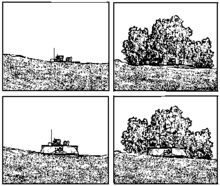In a recent column we mentioned the phrase, “hull down.” In the great days of sail, this was the lookout’s way of communicating the distance to a ship he’s sighted, just coming over the horizon. So how far away is a ship that’s “hull down?”

The formula is the same simple one we use in piloting to tell how far off we are when “dipping a light” on a lighthouse. The square root of the height of our eye above the water in feet times 1.17 yields the distance to the horizon in nautical miles. If we use 16 feet as the height of eye—about the height of the forecastle head (bow) where we’ll have our lookout—we get a result of approximately four and a half miles (SQRT 16 = 4 x 1.17 = 4.68). Eric Hiscock’s “Beyond The West Horizon” sounds like a romantically distant place, but it’s only as far away as Angel Island. Now, to get the distance to the lighthouse, or in our case the mast of the enemy, you add the figure above to the result of the same formula when applied to the estimated height of the sails we see.
The mast of a full rigged ship will be, say, 150 feet tall (it could be more—HMS Victory had a mainmast that rose 205 feet above the waterline, for example). Doing the math (SQRT 150 = 12.24 x 1.17=14.3) and adding the height of eye figure above (4.68) we get around 19 nautical miles. On a windy day when they’ve doused their royals and topgallants, she’ll be somewhat closer when we first see her, about 16 miles. If we move our lookout up to the fore-top, he’ll be somewhere in the vicinity of 80 feet above the water. We’ll see her sooner if we have our man there, at about 23 miles. The range on a clear day, then, is between 16 and 23 miles. If we’re sailing towards one another the closing speed could be as high as 16-18 knots, so we’ll be within an hour or a little more of her. Beat to Quarters! On the other hand if she’s chasing us and closing at only a knot or less, it could take a day or more to reach us. When the sighted ship is “hull up” it means that the lookout can see the forecastle so she is much closer, so we can do the same calculations as above, but instead of using 150 feet for the top of the mast, we’ll use about 16 as the height of the bow.
There’s a modern use for this ancient observation technique that we can benefit from, which we’ll get to next time.

Thank you Tony for the timely articles on compass points and “hull down.” I’d never heard this phrase before, but thanks to you when it came up in Joshua Slocum’s “Sailing Alone Around the World” the other day I knew what he was talking about!